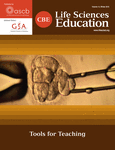Evidence-Based Medicine as a Tool for Undergraduate Probability and Statistics Education
Abstract
Most students have difficulty reasoning about chance events, and misconceptions regarding probability can persist or even strengthen following traditional instruction. Many biostatistics classes sidestep this problem by prioritizing exploratory data analysis over probability. However, probability itself, in addition to statistics, is essential both to the biology curriculum and to informed decision making in daily life. One area in which probability is particularly important is medicine. Given the preponderance of pre health students, in addition to more general interest in medicine, we capitalized on students’ intrinsic motivation in this area to teach both probability and statistics. We use the randomized controlled trial as the centerpiece of the course, because it exemplifies the most salient features of the scientific method, and the application of critical thinking to medicine. The other two pillars of the course are biomedical applications of Bayes’ theorem and science and society content. Backward design from these three overarching aims was used to select appropriate probability and statistics content, with a focus on eliciting and countering previously documented misconceptions in their medical context. Pretest/posttest assessments using the Quantitative Reasoning Quotient and Attitudes Toward Statistics instruments are positive, bucking several negative trends previously reported in statistics education.



